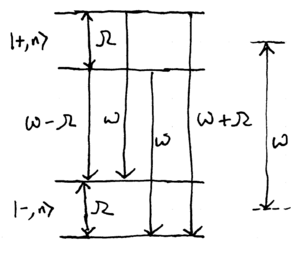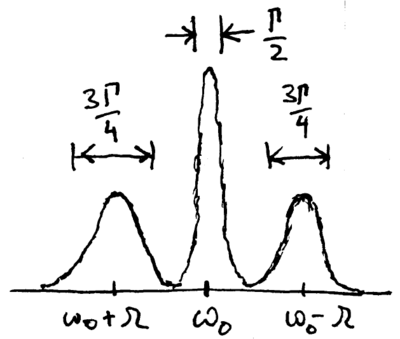Difference between revisions of "Solutions of the optical Bloch equations"
imported>Ketterle |
imported>Ichuang |
||
| Line 150: | Line 150: | ||
\,. | \,. | ||
\end{array}</math> | \end{array}</math> | ||
| + | |||
| + | === Visualization: Bloch vector === | ||
| + | |||
Visulization of the evolution of a density matrix under the optical | Visulization of the evolution of a density matrix under the optical | ||
Bloch equations is thus helped by rewriting them in terms of a | Bloch equations is thus helped by rewriting them in terms of a | ||
| Line 178: | Line 181: | ||
which shrinks <math>\hat{x}</math> and <math>\hat{y}</math> components of the Bloch vector, | which shrinks <math>\hat{x}</math> and <math>\hat{y}</math> components of the Bloch vector, | ||
while moving the <math>\hat{z}</math> component toward <math>r_z=1</math>. | while moving the <math>\hat{z}</math> component toward <math>r_z=1</math>. | ||
| + | |||
| + | |||
| + | === Physics: in-phase and quadrature components === | ||
Physically, what is the meaning of <math>r_x</math>, <math>r_y</math>, and <math>r_z</math>? <math>r_z</math> is | Physically, what is the meaning of <math>r_x</math>, <math>r_y</math>, and <math>r_z</math>? <math>r_z</math> is | ||
| Line 194: | Line 200: | ||
dipole moment which are in-phase and in quadrature with the incident | dipole moment which are in-phase and in quadrature with the incident | ||
electromagnetic field. | electromagnetic field. | ||
| + | |||
| + | === Animation of full solutions === | ||
Here are plots of the full solutions of the optical Bloch equations on the Bloch sphere, for various cases of <math>g</math>, <math>\delta</math>, and <math>\Gamma</math> (sample matlab files to solve the differential equations: [http://cua.mit.edu/wikipost/20090304-131009/obefun1.m.txt obefun1.m] | Here are plots of the full solutions of the optical Bloch equations on the Bloch sphere, for various cases of <math>g</math>, <math>\delta</math>, and <math>\Gamma</math> (sample matlab files to solve the differential equations: [http://cua.mit.edu/wikipost/20090304-131009/obefun1.m.txt obefun1.m] | ||
Revision as of 15:40, 1 May 2009
The optical Bloch equations
provide a time-dependent quantum description of a spontaneously emitting atom driven by a classical electromagnetic field. Considerable insight into the physical processes involved can be gained by studying these equations in the transient excitation limit, as well as the steady-state limit, as we see in this section. We begin by considering the coherent part of the evolution, then extend this to re-visit the Bloch sphere picture of the optical Bloch equations, which provides useful visualizations of transient responses and steady state solutions. Finally, we return to vacuum Rabi oscillations and investigate how cavity loss leads to damping of the oscillations, as an illustration of master equations which are more general than the optical Bloch equation.
Contents
Eigenstates of the Jaynes-Cummings Hamiltonian
The Hamiltonian involved in the optical Bloch equations,
describes the evolution of an atom in a classical field. We begin here by reviewing the coherent evolution under .
arises from the Jaynes-Cummings interaction we have previously considered in the context of cavity QED, describing a single two-level atom interacting with a single mode of the electromagnetic field:
The last term in this expression is , the dipole interaction between atom and field. By defining and , we may write this interaction as
In the frame of reference of the atom and field, recall that
When near resonance, , and because the and terms oscillate at nearly twice the frequency of , those terms can be dropped. Doing so is known as the rotating wave approximation, and it gives us a simplified interaction Hamiltonian
Under this approximation, it is useful to note that this interaction merely exchanges one quantum of excitation from atom to field, and back, so that the total number of excitations is a constant of the motion. We may thus write the total Hamiltonian, in the rotating wave approximation, as
where we have defined , and . Below, we may use to simplify writing.
What are the eigenstates of this Hamiltonian? It describes a two-level system coupled to a simple harmonic oscillator; when uncoupled, if , then the eigenstates are simply those of , and , as shown here:
When coupled, degenerate energy levels split (this is sometimes called dynamimc Stark splitting), with harmonic oscillator levels and splitting into two energy levels separated by . Since the coupling only pairs levels separated by one quantum of excitation, it is straightforward to show that the eigenstates of the Jaynes-Cummings Hamiltonian fall into well defined pairs of states, which we may label as ; these are
and they have energies
When , similar physics result, but with slightly more complicated expressions describing the eigenstates, as we shall see when we later return to the "dressed states" picture.
Strongly driven atom: Mollow triplet
An atom strongly coupled to a single mode electromagnetic field, or an atom driven strongly by a single mode field, will thus have an emission spectrum described by the coupled energy level diagram:
where, to good approximation, the energy level differences are and . These three lines which appear in the spectrum are known as the Mollow triplet:
The Mollow triplet is experimentally observed in a wide variety of systems. However, while our energy eigenstate analysis has predicted the number and frequencies of the emission lines, it fails to explain a key characteristic: the widths are not the same. If the central peak at has width HWHM , the two sidebands each have a HWHM of . To explain this, we need the optical Bloch equations.
Optical Bloch equation evolution on the Bloch sphere
We have previously seen that an arbitrary qubit state can be represented as being a point on a unit sphere, located at in polar coordinates. Similarly, a density matrix may be depicted as being a point inside or on the unit sphere, using
where is the Bloch vector representation of .
Explicitly, if we let
then
Visualization: Bloch vector
Visulization of the evolution of a density matrix under the optical Bloch equations is thus helped by rewriting them in terms of a differential equation for . A convenient starting point for this is the optical Bloch equation
using the rotating frame Hamiltonian (suppressing )
This gives us the equations of motion
Note how these equations of motion provide a simple set of flows on the Bloch sphere: the terms correspond to a rotation in the plane, corresponds to a rotation in the plane, and drives a relaxation process which shrinks and components of the Bloch vector, while moving the component toward .
Physics: in-phase and quadrature components
Physically, what is the meaning of , , and ? is manifestly the population difference between the excited and ground states. The other two components may be interpreted by recognizing that the average dipole moment of the atom is
Thus, and correspond to the phase components of the atomic dipole moment which are in-phase and in quadrature with the incident electromagnetic field.
Animation of full solutions
Here are plots of the full solutions of the optical Bloch equations on the Bloch sphere, for various cases of , , and (sample matlab files to solve the differential equations: obefun1.m plotobe2.m):
<jwplayer width="560" height="440" repeat="true" displayheight="420" image="http://feynman.mit.edu/8.422/plotobe6.png" autostart="false">http://feynman.mit.edu/8.422/plotobe6.flv</jwplayer>
Solutions of the optical Bloch equations
The optical Bloch equations, describing the evolution of a single atom coupled to the vacuum,
are a set of three coupled differential equations,
written in the rotating frame of the atom's Hamiltonian. These equations can be solved analytically, but a great deal of intuition can be obtained from just studying the solutions in several limits. Here, we consider the steady state, transient, and weak excitation limits.
Transient response of the optical Bloch equations
The optical Bloch equations allow us to study the internal state of the atom as it changes due to the external driving field, and due to spontaneous emission.
Starting from the time-independent form of the equations,
we may note that when and at resonance, , the Bloch vector exhibits pure damping behavior, towards , and . Note that a convenient way to write these differential equations is in matrix form,
When , Rabi oscillations occur, represnted by rapid rotations of the Bloch vector about . Since the relaxation along occurs at rate , and the relaxation about occurs at rate , we might expect that the average relaxation rate of the rotating components under such a strong driving field would be . The remaining component does not rotate, because it sits along , the axis of rotation. Thus, it relaxes with rate . Computation of the eigenvalues of the equations of motion verify this qualitative picture, and show that for , and , the eigenvalues of motion are and .
These correspond to a main peak at with width , and two sidebands at , with widths , thus explaining the widths of the observed Mollow triplet lines.
Steady-state solution of the optical Bloch equations
The steady state solution of the optical Bloch equations are found by setting all the time derivatives to zero, giving a set of three simultaneous equations,
The solutions are (up to overall minus signs which can be absorbed into definitions):
Physically, these are Lorentzians; the solution (the component in quadrature with the dipole) corresponds to an absorption curve with half-width
and the solution (the component in-phase with the dipole) corresponds to a dispersion curve. And under a strong driving field, as , , indicating that the populations in the excited and ground states are equalizing. The steady-state population in the excited state is
an important result that will later be used in studying light forces.
These solutions can be re-expressed in a simplified manner by defining
the saturation parameter
in terms of which we find
As , the atomic transitions become saturated, and the linewidth of the transition broadens from its natural value , becoming on resonance, at .
Here are plots of the steady state solution for varying :
<jwplayer width="560" height="440" repeat="true" displayheight="420" image="http://feynman.mit.edu/8.422/steady4.png" autostart="false">http://feynman.mit.edu/8.422/steady4.flv</jwplayer>
Weak excitation limit solution of the optical Bloch equations
Once again, the time-independent form of the optical Bloch equations is
where the remaining two components of the density matrix are given by , and . It is insightful to study these equations in the limit of weak excitation, and for short evolution times.
It turns out that the solution of these equations to lowest order in , and in the limit , with the initial conditions and , gives
Moreover the solution of these equations to lowest order in in the limit , with the initial conditions and , gives
irrespective of the values of and .
Damped vacuum Rabi oscillations
The optical Bloch equations can be generalized to describe not just an atom interacting with the vacuum, but also an atom and a single cavity mode, each interacting with its own reservoir. This is the master equation for cavity QED, and using such a master equation we can revisit the phenomenon of vacuum Rabi oscillations and see what happens in the presence of damping.
Generalization of the optical Bloch equations
The starting point for generalizing the optical Bloch equations is the Lindblad form we previously saw in the full-derivation walkthrough,
In this expression, and are "jump operators," and represent changes that occur to the atom when distinct dissipative events happen ("distinct" meaning that the environment changes between orthogonal states).
We may write the master equation for our more general scenario by replacing the atomic density matrix by a general density matrix representing the atom and cavity field, and by replacing the atomic jump operators with general jump operators ,
Note that the include normalization factors which reflect their probabilities of occurrence. In other words, for the atom + vacuum model, .
Master equation for cavity QED system
For the cavity QED model, the atom and cavity field each have possible jump operators. In general, the atom and cavity may both couple to a thermal field with average photons. In such a case, the jump operators are , , , and , where parameterizes the spontaneous emission rate of the atom in free space, and is parameterizes the cavity factor.
Experimentally, typically the environment, the vacuum, is essentially at zero temperature, so , in which case the only two relevant jump operators are and .
Damped vacuum Rabi oscillations
Vacuum Rabi oscillations, in the absence of damping, involve only two states of the atom and cavity: and . When damping is added, the state must be included, since both the atom and cavity states can decay and loose their quanta of energy. Moreover, because only one quantum of excitation is involved in this system, we can observe the essential physics by considering the case when is zero (no spontaneous emission), but is nonzero (the cavity is leaky). Let be the vacuum Rabi frequency, and denote this three state space by , , and . Written out explicitly in terms of the density matrix elements , the master equation is (for the case with the system starting in the state )
When the cavity damping rate is small, , then the vacuum Rabi oscillations are damped, with average damping rate since the atoms spend roughly half their time in the excited state.
When the cavity damping rate is large, , then the atomic excitation is irreversibly damped, and no oscillations occur. Let be the probability of being in the state. We can combine two of the above equations to write
Since in this case , and , it follows that
Since in this regime, we slowly try to populate state while it quickly decays away, we can approximate giving
Finally plugging this back into the optical bloch equation for yields
so decays exponentially, with rate . Note that a large cavity damping rate slows down the decay of the atom's excited state. This is due to the fact that the stimulated transition (Rabi oscillation) to the lower state is slowed down by the cavity damping (which is a manifestation of the quantum Zeno effect).
Purcell factor: cavity enhanced spontaneous emission
How does this compare with the free space spontaneous emission rate ? Recall that the vacuum Rabi frequency is (for the case that the dipole matrix element vector and cavity mode polarization are aligned)
where is the atomic dipole moment and is the electric field amplitude of a single photon at the atomic transition frequency (Note that this is a standing wave in a cavity so it is a factor of two larger than the field for a running wave),
and is the cavity volume. This gives
Letting , we thus find that
as the decay rate of the atom in the cavity.
Recall that the spontaneous emission rate of an atom in free space, as determined by Fermi's golden rule, is
The ratio of this rate to the decay rate in the cavity is
where we take as being the wavelength of the cavity field, which is assumed to be resonant with the atomic transition frequency . Note that is independent of the atomic dipole strength, and determined solely by cavity parameters. Moreover, note that for small, high- cavities, the decay rate of the atom in the cavity can be much larger than the free space spontaneous emission rate. This "cavity enhanced" spontaneous emission rate was predicted by Purcell (1946), an observation credited as being the starting point of cavity QED.
![{\displaystyle {\dot {\rho }}=-{\frac {i}{\hbar }}[H,\rho ]-{\frac {\Gamma }{2}}\left[{\sigma _{+}\sigma _{-}\rho -2\sigma _{-}\rho \sigma _{+}+\rho \sigma _{+}\sigma _{-}}\right]\,,}](https://wikimedia.org/api/rest_v1/media/math/render/svg/604d2158dbbebf16674738f973827dbb18e3a819)


![{\displaystyle H_{JC}={\frac {\hbar \omega _{0}}{2}}\left[{|e\rangle \langle e|-|g\rangle \langle g|}\right]+\hbar \omega a^{\dagger }a+{\frac {\hbar \Omega }{2}}\left[{|g\rangle \langle e|+|e\rangle \langle g|}\right]\left[{a+a^{\dagger }}\right]\,.}](https://wikimedia.org/api/rest_v1/media/math/render/svg/630609e3aab033690555f530c6e4323ba84a5538)



![{\displaystyle H_{I}={\frac {\hbar \Omega }{2}}\left[{\sigma _{+}+\sigma _{-}}\right]\left[{a+a^{\dagger }}\right]\,.}](https://wikimedia.org/api/rest_v1/media/math/render/svg/3410ceeb8ffe707f367fc599209a8dad817b08df)





![{\displaystyle H_{I}={\frac {\hbar \Omega }{2}}\left[{a^{\dagger }\sigma _{+}+a\sigma _{-}}\right]\,.}](https://wikimedia.org/api/rest_v1/media/math/render/svg/508bc170a806987fec962bd6efde10f42f6acb93)













![{\displaystyle |\pm ,n\rangle ={\frac {1}{\sqrt {2}}}\left[{|e,n\rangle \pm |g,n+1\rangle }\right]\,,}](https://wikimedia.org/api/rest_v1/media/math/render/svg/55f08b48a6a98c378c7ba35aff03487dd1c3463e)













![{\displaystyle \rho =\left[{\begin{array}{cc}{\rho _{ee}}&{\rho _{eg}}\\{\rho _{ge}}&{\rho _{gg}}\end{array}}\right]\,,}](https://wikimedia.org/api/rest_v1/media/math/render/svg/614be7a08a95774b74f988c678248fd3055558a9)




















![{\displaystyle {\dot {\vec {r}}}=\left[{\begin{array}{ccc}{-\Gamma /2}&{0}&{0}\\{0}&-\Gamma /2&-g\\0&g&-\Gamma \end{array}}\right]{\vec {r}}+\left[{\begin{array}{c}0\\0\\\Gamma \end{array}}\right]}](https://wikimedia.org/api/rest_v1/media/math/render/svg/fb43942f8e6ec5fc6cff697ce6da0b596d03ffa9)






















![{\displaystyle \rho _{ee}={\frac {{\frac {1}{4}}|\Omega |^{2}}{(\omega _{0}-\omega _{L})^{2}+\left({\frac {\Gamma }{2}}\right)^{2}}}\left[{1+e^{-\Gamma t}-2\cos[(\omega _{0}-\omega _{L})t]e^{-\Gamma t/2}}\right]\,.}](https://wikimedia.org/api/rest_v1/media/math/render/svg/b64625925fd7fe28a344e9c52505541e0de0c430)



![{\displaystyle {\dot {\rho }}_{A}=-{\frac {i}{\hbar }}[H,\rho _{A}]-{\frac {\Gamma }{2}}\left[{\sigma _{+}\sigma _{-}\rho _{A}-2\sigma _{-}\rho _{A}\sigma _{+}+\rho _{A}\sigma _{+}\sigma _{-}}\right]\,.}](https://wikimedia.org/api/rest_v1/media/math/render/svg/13bf26eb3d88c4444078e147d8e6751295dea1fd)




![{\displaystyle {\dot {\rho }}=-{\frac {i}{\hbar }}[H,\rho ]+\sum _{k}\left[{L_{k}\rho L_{k}^{\dagger }-{\frac {1}{2}}(L_{k}^{\dagger }L_{k}\rho +\rho L_{k}^{\dagger }L_{k})}\right]\,.}](https://wikimedia.org/api/rest_v1/media/math/render/svg/f41a3c9853e8923bf9cfd246f4affa45f6e6039a)
















































